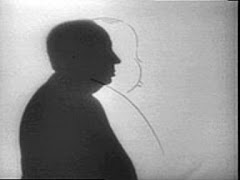Williams has just had an article on a non-francophone director published in the 50th anniversary issue of the journal Film Quarterly (Fall Issue 2008, Vol. 62, No. 1, pp. 46-57). It's available online if you have a subscription or JSTOR (etc) access. The article is entitled 'The Rhythms of Life: An Appreciation of Michelangelo Antonioni, Extreme Aesthete of the Real'. The abstract reads as follows:
This essay assesses Antonioni’s oeuvre in its totality, focusing in particular on its constant negotiation of two extremes: documentary and melodrama. The essay argues that Antonioni’s is a visionary project which, by achieving a genuine encounter between art and technology, extends an earlier tradition of the European avant-garde. [hyperlinks added]
What I think is especially valuable about this essay is that it treats Antonioni's film techniques, across all of his work, in much more detail than most other studies (and, certainly, than all other studies I have read of academic article length). It manages to make, as many other works do, plenty of interesting observations about Antonioni's themes, but it does not subordinate an exploration of formal aesthetics in the process: its focus remains assuredly and insightfully on how Antonioni’s techniques 'resensitize us to the world' [p. 53]
Williams notes that Antonioni's 'highly ambivalent aesthetic attitude to documentary reality was already visible at the beginning of his career':
Despite Antonioni’s deep concerns about scientific logic and any objective representation of reality, in purely formal terms his work is always defined by a clear tension between what I would call on the one hand a documentary impulse, and on the other a drive towards fiction pushed at times to the level of melodrama.
[...] however hollowed-out and experimental Antonioni’s works become, they always constitute fictions since they present characters in artificial situations. As Antonioni himself put it, his primary interest lies in the moment when the context or environment suddenly takes on “relief.” Which is to say, his hybrid narratives marked by temporal disjunction, disorientation, black holes, ellipses, and a lack of resolution serve to provide just enough justification for human figuration, however “unnaturally” heightened and stylized, to take hold. This recourse to melodrama, broadly defined, offered Antonioni a means of shortcircuiting and sculpting the Real in slowed-down, distended form in order to capture it as a series of tableaux vivants. [p. 50]
Williams' article is especially good, I feel, on Antonioni's deployment of melodrama in the interests of 'an exploration of the processes of human perception and modern subjectivity':
Alert to the tensions in the spatiotemporal relations between people, objects, and events, the director must, according to Antonioni, engage with a “special reality” and be “committed morally in some way.” What this means in practice is dedramatizing the narrative event in order to focus attention on the physical context that both makes it possible but also eludes it. Antonioni propels his protagonists into new or alien environments, and we follow them almost ethnographically as they develop new perceptual powers in order to negotiate their changed conditions'. [p. 52]
In a section of the article entitled 'A New Techno-Aesthetic?', an insightful connection is made between Antonioni's melodramatic techniques and what fellow Italian filmmaker Pier Paolo Pasolini, in his famous essay, 'Cinema of Poetry', called Antonioni's free indirect subjective [p. 55 - see Patrick Keating's useful article online HERE for a good discussion of Pasolini's essay).
I'm not teaching about Antonioni's films to students at the moment, but, if I were, Williams' beautifully written and gloriously illustrated essay would be top of the class-reading list. Please don't just take my inevitably biased word for it: take a proper look at it yourselves.
Other online resources I have used previously in teaching about this Italian director are given below.
HERE's a link to the excellent bibliography of materials on Michelangelo Antonioni provided by the UC Berkeley Library.
And below are some links to other, good, online articles:
- James Brown, "Michelangelo Antonioni." (profile and film survey) Senses of Cinema
- James Brown, "Il Grido: Modernising the Po." Senses of Cinema
- Gregory Solman, "L'Avventura." Senses of Cinema
- Absjørn Grønstad, "Anatomy of a Murder: Bazin, Barthes, Blow-Up." Film Journal
- Jack Turner, "Antonioni's The Passenger as Lacanian Text." Other Voices
- Fiona A.Villella, "Here Comes the Sun: New Ways of Seeing In Antonioni's Zabriskie Point." Senses of Cinema
- Ian Johnston, 'We’re Not Happy and We Never Will Be: On Cronaca di un amore', Bright Lights Film Journal







